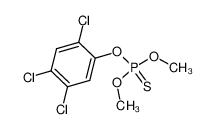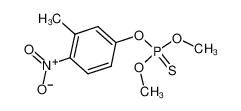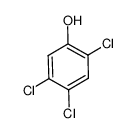1.Identification
1.1 GHS Product identifier
| Product name | fenchlorphos |
|---|
1.2 Other means of identification
| Product number | - |
|---|---|
| Other names | Fenclofos |
1.3 Recommended use of the chemical and restrictions on use
| Identified uses | For industry use only. Insecticide |
|---|---|
| Uses advised against | no data available |
1.4 Supplier's details
| Company | MOLBASE (Shanghai) Biotechnology Co., Ltd. |
|---|---|
| Address | Floor 4 & 5, Building 12, No. 1001 North Qinzhou Road, Xuhui District, Shanghai, China |
| Telephone | +86(21)64956998 |
| Fax | +86(21)54365166 |
1.5 Emergency phone number
| Emergency phone number | +86-400-6021-666 |
|---|---|
| Service hours | Monday to Friday, 9am-5pm (Standard time zone: UTC/GMT +8 hours). |
2.Hazard identification
2.1 Classification of the substance or mixture
Acute toxicity - Oral, Category 4
Acute toxicity - Dermal, Category 4
Hazardous to the aquatic environment, short-term (Acute) - Category Acute 1
Hazardous to the aquatic environment, long-term (Chronic) - Category Chronic 1
2.2 GHS label elements, including precautionary statements
| Pictogram(s) |   |
|---|---|
| Signal word | Warning |
| Hazard statement(s) | H302 Harmful if swallowed H312 Harmful in contact with skin H410 Very toxic to aquatic life with long lasting effects |
| Precautionary statement(s) | |
| Prevention | P264 Wash ... thoroughly after handling. P270 Do not eat, drink or smoke when using this product. P280 Wear protective gloves/protective clothing/eye protection/face protection. P273 Avoid release to the environment. |
| Response | P301+P312 IF SWALLOWED: Call a POISON CENTER/doctor/…if you feel unwell. P330 Rinse mouth. P302+P352 IF ON SKIN: Wash with plenty of water/... P312 Call a POISON CENTER/doctor/…if you feel unwell. P321 Specific treatment (see ... on this label). P362+P364 Take off contaminated clothing and wash it before reuse. P391 Collect spillage. |
| Storage | none |
| Disposal | P501 Dispose of contents/container to ... |
2.3 Other hazards which do not result in classification
none
3.Composition/information on ingredients
3.1 Substances
| Chemical name | Common names and synonyms | CAS number | EC number | Concentration |
|---|---|---|---|---|
| fenchlorphos | fenchlorphos | 299-84-3 | none | 100% |
4.First-aid measures
4.1 Description of necessary first-aid measures
General advice
Consult a physician. Show this safety data sheet to the doctor in attendance.
If inhaled
Fresh air, rest. Refer for medical attention.
In case of skin contact
Remove contaminated clothes. Rinse and then wash skin with water and soap. Refer for medical attention .
In case of eye contact
First rinse with plenty of water for several minutes (remove contact lenses if easily possible), then refer for medical attention.
If swallowed
Induce vomiting (ONLY IN CONSCIOUS PERSONS!). Refer for medical attention .
4.2 Most important symptoms/effects, acute and delayed
Exposure Routes: inhalation, ingestion, skin and/or eye contact Target Organs: Eyes, liver, kidneys, blood plasma (NIOSH, 2016)
4.3 Indication of immediate medical attention and special treatment needed, if necessary
7C. AFTER ASPIRATION OF GASTRIC CONTENTS & WASHING OF STOMACH, INSTILL /PRC- 30 G OF ACTIVATED CHARCOAL IN 3-4 OZ OF WATER (CHILDREN), 100 G IN 8-10 OZ WATER (ADULTS)/ ... THROUGH STOMACH TUBE TO LIMIT ABSORPTION OF REMAINING TOXICANT. ... D. IF BOWEL MOVEMENT HAS NOT OCCURRED IN 4 HR, & ... PATIENT IS FULLY CONSCIOUS, GIVE SODIUM SULFATE, 0.25 G/KG, IN 6-8 OZ OF WATER, AS CATHARTIC. MAGNESIUM SULFATE & CITRATE ARE EQUALLY SUITABLE ... . RETAINED MAGNESIUM MAY DEPRESS CNS FUNCTION. 8. DO NOT ADMIN MORPHINE, AMINOPHYLLINE, PHENOTHIAZINES, OR RESERPINE, FUROSEMIDE, OR ETHACRYNIC ACID ... . /ORGANOPHOSPHATE PESTICIDES/
5.Fire-fighting measures
5.1 Extinguishing media
Suitable extinguishing media
Excerpt from ERG Guide 154 [Substances - Toxic and/or Corrosive (Non-Combustible)]: SMALL FIRE: Dry chemical, CO2 or water spray. LARGE FIRE: Dry chemical, CO2, alcohol-resistant foam or water spray. Move containers from fire area if you can do it without risk. Dike fire-control water for later disposal; do not scatter the material. FIRE INVOLVING TANKS OR CAR/TRAILER LOADS: Fight fire from maximum distance or use unmanned hose holders or monitor nozzles. Do not get water inside containers. Cool containers with flooding quantities of water until well after fire is out. Withdraw immediately in case of rising sound from venting safety devices or discoloration of tank. ALWAYS stay away from tanks engulfed in fire. (ERG, 2016)
5.2 Specific hazards arising from the chemical
Excerpt from ERG Guide 154 [Substances - Toxic and/or Corrosive (Non-Combustible)]: Non-combustible, substance itself does not burn but may decompose upon heating to produce corrosive and/or toxic fumes. Some are oxidizers and may ignite combustibles (wood, paper, oil, clothing, etc.). Contact with metals may evolve flammable hydrogen gas. Containers may explode when heated. For electric vehicles or equipment, ERG Guide 147 (lithium ion batteries) or ERG Guide 138 (sodium batteries) should also be consulted. (ERG, 2016)
5.3 Special protective actions for fire-fighters
Wear self-contained breathing apparatus for firefighting if necessary.
6.Accidental release measures
6.1 Personal precautions, protective equipment and emergency procedures
Use personal protective equipment. Avoid dust formation. Avoid breathing vapours, mist or gas. Ensure adequate ventilation. Evacuate personnel to safe areas. Avoid breathing dust. For personal protection see section 8.
6.2 Environmental precautions
Personal protection: particulate filter respirator adapted to the airborne concentration of the substance. Do NOT let this chemical enter the environment. Sweep spilled substance into sealable containers. If appropriate, moisten first to prevent dusting. Carefully collect remainder. Then store and dispose of according to local regulations. Do NOT wash away into sewer.
6.3 Methods and materials for containment and cleaning up
1. Ventilate area of spill. 2. Collect spilled material in the most convenient & safe manner & deposit in sealed containers for reclamation, or for disposal in a secured sanitary landfill. Molten ronnel should be absorbed in vermiculite, dry sand, earth, or a similar material.
7.Handling and storage
7.1 Precautions for safe handling
Avoid contact with skin and eyes. Avoid formation of dust and aerosols. Avoid exposure - obtain special instructions before use.Provide appropriate exhaust ventilation at places where dust is formed. For precautions see section 2.2.
7.2 Conditions for safe storage, including any incompatibilities
Separated from strong oxidants and food and feedstuffs.... MUST BE STORED IN ITS SEALED ORIGINAL CONTAINERS, IN WELL-AIRED, FRESH & DRYSTOREHOUSES OR IN SHADED & POSSIBLY WELL-AIRED PLACES. IT IS RECOMMENDED THAT THE PRODUCT'S TEMP ... NOT EXCEED 25-30 DEG C, & KEEP ... AWAY FROM SOURCES OF HEAT FREE FLAMES OR SPARK-GENERATING EQUIPMENT. CONTAINERS MUST BE STACKED IN SUCH A WAY AS TO PERMIT FREE CIRCULATION OF AIR ... AT BOTTOM & INSIDE OF PILES. STORAGE AREAS MUST BE LOCATED AT SUITABLE DISTANCE FROM INHABITED BUILDINGS, ANIMAL SHELTERS, & FOOD STORES; MOREOVER, THEY MUST BE INACCESSIBLE TO UNAUTHORIZED PERSONS, CHILDREN, & DOMESTIC ANIMALS. /PROTHOATE/
8.Exposure controls/personal protection
8.1 Control parameters
Occupational Exposure limit values
Recommended Exposure Limit: 10 Hr Time-Weighted Avg: 10 mg/cu m.
Biological limit values
no data available
8.2 Appropriate engineering controls
Handle in accordance with good industrial hygiene and safety practice. Wash hands before breaks and at the end of workday.
8.3 Individual protection measures, such as personal protective equipment (PPE)
Eye/face protection
Safety glasses with side-shields conforming to EN166. Use equipment for eye protection tested and approved under appropriate government standards such as NIOSH (US) or EN 166(EU).
Skin protection
Wear impervious clothing. The type of protective equipment must be selected according to the concentration and amount of the dangerous substance at the specific workplace. Handle with gloves. Gloves must be inspected prior to use. Use proper glove removal technique(without touching glove's outer surface) to avoid skin contact with this product. Dispose of contaminated gloves after use in accordance with applicable laws and good laboratory practices. Wash and dry hands. The selected protective gloves have to satisfy the specifications of EU Directive 89/686/EEC and the standard EN 374 derived from it.
Respiratory protection
Wear dust mask when handling large quantities.
Thermal hazards
no data available
9.Physical and chemical properties
| Physical state | Ronnel is a white to light-tan crystalline solid. Mp: 41° C, Density :1.49 g cm-3 at 25°C. Biocidal (toxic to all animal life in differing degrees) by its action as a cholinesterase inhibitor. Used as an insecticide. Degrades readily in the environment by hydrolysis and oxidation. |
|---|---|
| Colour | COLORLESS CRYSTALS |
| Odour | Mercaptan odor |
| Melting point/ freezing point | 35ºC |
| Boiling point or initial boiling point and boiling range | 97 at 0.01 mm Hg |
| Flammability | Noncombustible SolidNot combustible. Liquid formulations containing organic solvents may be flammable. Gives off irritating or toxic fumes (or gases) in a fire. |
| Lower and upper explosion limit / flammability limit | no data available |
| Flash point | 162.3ºC |
| Auto-ignition temperature | no data available |
| Decomposition temperature | no data available |
| pH | no data available |
| Kinematic viscosity | no data available |
| Solubility | 0.004 % at 25°C (NIOSH, 2016) |
| Partition coefficient n-octanol/water (log value) | log Kow= 5.07 |
| Vapour pressure | 3.15E-05mmHg at 25°C |
| Density and/or relative density | 1.527g/cm3 |
| Relative vapour density | no data available |
| Particle characteristics | no data available |
10.Stability and reactivity
10.1 Reactivity
no data available
10.2 Chemical stability
STABLE AT TEMP UP TO 60 DEG C, IN NEUTRAL & ACIDIC MEDIA
10.3 Possibility of hazardous reactions
RONNEL is non-flammable and non-combustible. Decomposes with heating to evolve toxic and corrosive vapors (hydrogen chloride, phosphorus oxides, sulfur oxides). Incompatible with strong oxidizing agents.
10.4 Conditions to avoid
no data available
10.5 Incompatible materials
Strong oxidizers.
10.6 Hazardous decomposition products
When heated to decomposition it emits very toxic fumes of /hydrogen chloride/, oxides of phosphorus and oxides of sulfur.
11.Toxicological information
Acute toxicity
- Oral: LD50 Rat (male) oral 1250 mg/kg
- Inhalation: no data available
- Dermal: no data available
Skin corrosion/irritation
no data available
Serious eye damage/irritation
no data available
Respiratory or skin sensitization
no data available
Germ cell mutagenicity
no data available
Carcinogenicity
A4; Not classifiable as a human carcinogen.
Reproductive toxicity
no data available
STOT-single exposure
no data available
STOT-repeated exposure
no data available
Aspiration hazard
no data available
12.Ecological information
12.1 Toxicity
- Toxicity to fish: LC50 Lepomis macrochirus (bluegill) 1300 ug/l (95% confidence limit 1180-1430 ug/l), wt 1.0 g. Static bioassay without aeration, pH 7.2-7.5, water hardness 40-50 mg/l as calcium carbonate and alkalinity of 30-35 mg/l. /Technical material, 95%)
- Toxicity to daphnia and other aquatic invertebrates: no data available
- Toxicity to algae: no data available
- Toxicity to microorganisms: no data available
12.2 Persistence and degradability
Strains of microorganisms, Bacillus subtilis isolated from polluted water samples, completely degraded 8 ppm ronnel solution in less than 6 days(1). The mean of second order rate constant for microbial transformation of ronnel in natural river and pond waters was estimated to be 1.9X10-11 l/organisms-hr(2). Assuming that the concentration of microorganisms to be constant at 1.8X10+8 organisms/l(2), the half-life for the pseudo first order biotransformation rate can be estimated as 8.4 days(SRC). In a natural water sample, the biodegradation of ronnel showed a lag period of greater than 3 days. When a natural water sample was amended with inorganic nutrients (nitrogen, phosphorus, and traces of iron and magnesium), the lag period decreased by about 45% and of biodegradation half-life decreased to about half the value of an unamended solution(2).
12.3 Bioaccumulative potential
In a continuous flow-through system, the equilibrium bioconcentration factor (BCF) for ronnel in the guppy (Poecilia reticulata) was 43650 on the lipid weight basis(2). Based on a regression equation(1) and a log Kow value of 4.98(3), a whole-body BCF value of 3588 is estimated for ronnel(SRC). Therefore, bioconcentration of ronnel in aquatic organisms may be an important fate process(4,SRC).
12.4 Mobility in soil
Based on regression equations(3), log Koc values of 3.64 and 4.09 are estimated assuming a water solubility of 1 mg/l at 20°C(2) and a log Kow value of 4.98(1), respectively(SRC). These log Koc values indicate that ronnel would have a very low mobility in soil(4). Conversely, ronnel would remain strongly adsorbed to sediment and suspended solids in water(SRC). In sediment from Mississippi River that contained 1.4% organic carbon, 96% of ronnel was found in the sediment-sorbed phase(5).
12.5 Other adverse effects
no data available
13.Disposal considerations
13.1 Disposal methods
Product
The material can be disposed of by removal to a licensed chemical destruction plant or by controlled incineration with flue gas scrubbing. Do not contaminate water, foodstuffs, feed or seed by storage or disposal. Do not discharge to sewer systems.
Contaminated packaging
Containers can be triply rinsed (or equivalent) and offered for recycling or reconditioning. Alternatively, the packaging can be punctured to make it unusable for other purposes and then be disposed of in a sanitary landfill. Controlled incineration with flue gas scrubbing is possible for combustible packaging materials.
14.Transport information
14.1 UN Number
| ADR/RID: UN1145 | IMDG: UN1145 | IATA: UN1145 |
14.2 UN Proper Shipping Name
| ADR/RID: CYCLOHEXANE |
| IMDG: CYCLOHEXANE |
| IATA: CYCLOHEXANE |
14.3 Transport hazard class(es)
| ADR/RID: 3 | IMDG: 3 | IATA: 3 |
14.4 Packing group, if applicable
| ADR/RID: II | IMDG: II | IATA: II |
14.5 Environmental hazards
| ADR/RID: yes | IMDG: yes | IATA: yes |
14.6 Special precautions for user
no data available
14.7 Transport in bulk according to Annex II of MARPOL 73/78 and the IBC Code
no data available
15.Regulatory information
15.1 Safety, health and environmental regulations specific for the product in question
| Chemical name | Common names and synonyms | CAS number | EC number |
|---|---|---|---|
| fenchlorphos | fenchlorphos | 299-84-3 | none |
| European Inventory of Existing Commercial Chemical Substances (EINECS) | Listed. | ||
| EC Inventory | Listed. | ||
| United States Toxic Substances Control Act (TSCA) Inventory | Not Listed. | ||
| China Catalog of Hazardous chemicals 2015 | Not Listed. | ||
| New Zealand Inventory of Chemicals (NZIoC) | Not Listed. | ||
| Philippines Inventory of Chemicals and Chemical Substances (PICCS) | Not Listed. | ||
| Vietnam National Chemical Inventory | Not Listed. | ||
| Chinese Chemical Inventory of Existing Chemical Substances (China IECSC) | Not Listed. | ||
16.Other information
Information on revision
| Creation Date | Aug 20, 2017 |
|---|---|
| Revision Date | Aug 20, 2017 |
Abbreviations and acronyms
- CAS: Chemical Abstracts Service
- ADR: European Agreement concerning the International Carriage of Dangerous Goods by Road
- RID: Regulation concerning the International Carriage of Dangerous Goods by Rail
- IMDG: International Maritime Dangerous Goods
- IATA: International Air Transportation Association
- TWA: Time Weighted Average
- STEL: Short term exposure limit
- LC50: Lethal Concentration 50%
- LD50: Lethal Dose 50%
- EC50: Effective Concentration 50%
References
- IPCS - The International Chemical Safety Cards (ICSC), website: http://www.ilo.org/dyn/icsc/showcard.home
- HSDB - Hazardous Substances Data Bank, website: https://toxnet.nlm.nih.gov/newtoxnet/hsdb.htm
- IARC - International Agency for Research on Cancer, website: http://www.iarc.fr/
- eChemPortal - The Global Portal to Information on Chemical Substances by OECD, website: http://www.echemportal.org/echemportal/index?pageID=0&request_locale=en
- CAMEO Chemicals, website: http://cameochemicals.noaa.gov/search/simple
- ChemIDplus, website: http://chem.sis.nlm.nih.gov/chemidplus/chemidlite.jsp
- ERG - Emergency Response Guidebook by U.S. Department of Transportation, website: http://www.phmsa.dot.gov/hazmat/library/erg
- Germany GESTIS-database on hazard substance, website: http://www.dguv.de/ifa/gestis/gestis-stoffdatenbank/index-2.jsp
- ECHA - European Chemicals Agency, website: https://echa.europa.eu/


















-
-

-
-
-

-
-
-

-
-
-

-
-
-

-
-
-

-
-
-

-
-
-

-
-
-

-
-
-

-
More Suppliers>>Hangzhou J&H Chemical Co., Ltd.
CHINA
Purity: 98%
Lead Time: 14 Day(s)
Price: -
Henan Coreychem Co.,Ltd
CHINA
Purity: 98%
Lead Time: 3 Day(s)
Price: Min $1 /g
Shanghai Jizhi Biochemical Technology Co., Ltd.
CHINA
Purity: 100μg/m(u=6~2%,溶剂:丙酮)%
Lead Time: 1 Week(s)
Price: -
Hangzhou DayangChem Co., Ltd
CHINA
Purity: 97%
Lead Time: 7 Day(s)
Price: -
Targetmolecule Corp.
UNITED STATES
Purity: -%
Lead Time: 1 Day(s)
Price: Min $133 /mg
Shanghai Miner Chemical Technology Co., Ltd.
CHINA
Purity: 96%
Lead Time: 21 Day(s)
Price: Min $114.83 /mg
Shanghai Yusi Chemical Co., Ltd.
CHINA
Purity: 100%
Lead Time: 10 Day(s)
Price: Min $19.83 /ml
Saan Chemical Technology (Shanghai) Co., Ltd.
CHINA
Purity: 96%
Lead Time: 7 Day(s)
Price: Min $117.98 /mg
Shanghai Aladdin Bio-Chem Technology Co.,LTD
CHINA
Purity: 96%
Lead Time: 7 Day(s)
Price: Min $116.5 /mg
Santa Cruz Biotechnology, Inc.
UNITED STATES
Purity: 96%
Lead Time: 10 Day(s)
Price: Min $53 /mg